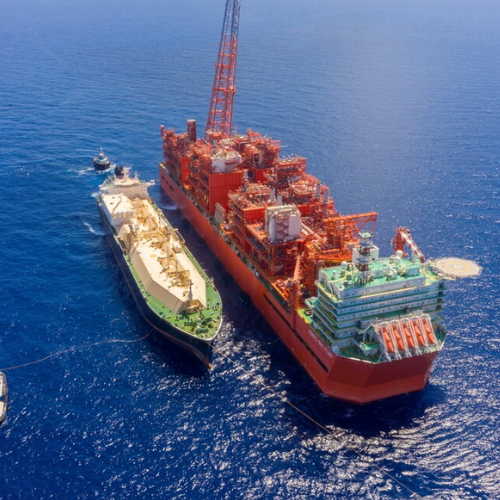The global FLNG (Floating Liquefied Natural Gas) market has been shaken by recent U.S. sanctions against a major Chinese shipyard. Last month, the U.S. government placed sanctions on Zhoushan Wison Offshore and Marine Limited, a Chinese company specializing in offshore plant construction. The reason? Wison Shipyard was found to be supplying power modules to a Russian liquefied natural gas (LNG) project.
This move has left Wison unable to accept new orders, creating a major shift in the market. Wison was one of only two companies in the world capable of constructing FLNG facilities. The other? South Korea’s Samsung Heavy Industries. Now, with Wison sidelined, Samsung Heavy Industries is in a prime position to dominate this sector.
Samsung Heavy Industries Becomes the FLNG Leader
Samsung Heavy Industries has long been a key player in the FLNG market. Floating Liquefied Natural Gas vessels are massive, high-tech floating plants that extract, liquefy, and store natural gas at sea. These projects are incredibly expensive, often costing between 2 to 3 trillion Korean won ($1.5 billion to $2.3 billion) each.
Sanctions Fallout: Russian Energy Official Defends Oil Trade with India
Before the sanctions, Wison had managed to secure a significant contract to build an FLNG unit for Delfin Midstream, a U.S.-based company. This was a surprise to many in the industry, as Samsung Heavy Industries had originally provided the basic design for the project. Delfin Midstream has plans for four FLNG units in the Gulf of Mexico, aiming to produce over 13 million tons of LNG annually.
Now that Wison is under sanctions, experts believe Samsung Heavy Industries is almost certain to secure the contracts for the remaining three units. This means Samsung could significantly boost its already impressive FLNG portfolio. The company has already secured orders for five projects, keeping its position as the world’s top FLNG builder.
Another key project in the pipeline for Samsung Heavy Industries is the second Coral Sul FLNG in Mozambique. The first Coral Sul FLNG, built by Samsung, was delivered in 2017. While the second unit was expected to be ordered last year, the decision was delayed. However, with the recent changes in the market, Samsung Heavy Industries is likely to move forward with this major deal soon.
Hanwha Ocean Enters the Race
While Samsung Heavy Industries dominates the FLNG sector, another South Korean company, Hanwha Ocean, is looking to strengthen its position. Hanwha Ocean was formerly known as Daewoo Shipbuilding & Marine Engineering. Back in 2016, it became the first company in the world to build an FLNG vessel, delivering it to Malaysia’s Petronas. However, after that, the company struggled to secure more orders.
Sanctions Shock: Russian ESPO Crude Faces Declining Demand in China
Now, under the Hanwha Group, the company is making a strong comeback in the offshore plant industry. Last year, Hanwha Ocean acquired several businesses to expand its capabilities. In April, it took over the wind power division of Hanwha Corporation’s construction unit and the plant business from Hanwha’s global sector. Later, in November, Hanwha Ocean and Hanwha Aerospace jointly acquired Singapore-based marine equipment manufacturer Dyna-Mac Holdings.
Dyna-Mac is a specialist in offshore plant superstructures and has expertise in building FLNG and floating production, storage, and offloading (FPSO) units. This acquisition is expected to boost Hanwha Ocean’s competitiveness in offshore projects. Currently, the company is constructing an FPSO for Brazil’s Petrobras in a deal worth 1.1 trillion won ($827 million).
A Hanwha Ocean official acknowledged that the U.S. sanctions on Chinese shipyards have created new opportunities in the FLNG and FPSO markets. With Wison unable to take on new orders, Hanwha Ocean is preparing to enter the race and compete for new projects.
The Future of FLNG Belongs to South Korea
With China’s Wison Shipyard effectively locked out of the market, Samsung Heavy Industries and Hanwha Ocean are now leading the FLNG industry. Samsung, already the dominant force, is securing new contracts, while Hanwha Ocean is working to reestablish itself in the market. As global demand for LNG rises, South Korean shipbuilders are expected to benefit the most from this shift in the industry.


